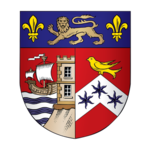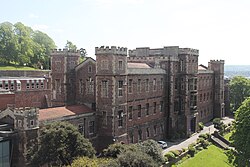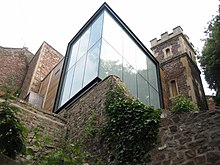
Queen Elizabeth's School, Barnet is a boys' grammar school in Barnet, northern Greater London, which was founded in 1573 by Robert Dudley, 1st Earl of Leicester, and others, in the name of Queen Elizabeth I.
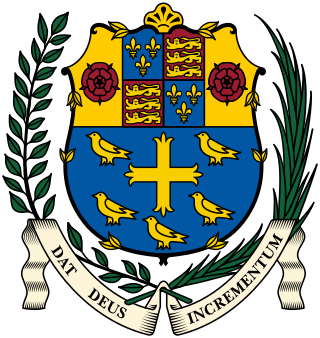
Westminster School is a public school in Westminster, London, England, in the precincts of Westminster Abbey. It descends from a charity school founded by Westminster Benedictines before the Norman Conquest, as documented by the Croyland Chronicle and a charter of King Offa. Continuous existence is clear from the early 14th century. Its academic results place it among the top schools nationally; about half its students go to Oxbridge, giving it the highest national Oxbridge acceptance rate. In the 2023 A-Levels, the school saw 82.3% of its candidates score A*/A.
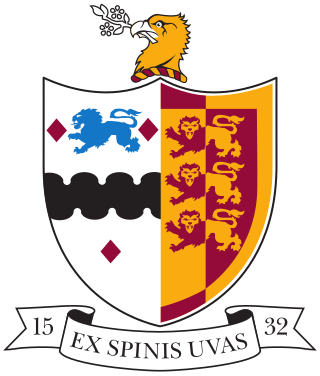
Bristol Grammar School (BGS) is a 4–18 mixed, private day school in Bristol, England. It was founded in 1532 by Royal Charter for the teaching of 'good manners and literature', endowed by wealthy Bristol merchants Robert and Nicholas Thorne who made their money through the work and trade of enslaved Africans. The school flourished in the early 20th century under headmaster Sir Cyril Norwood (1906–1916), embodying "the ideals and experiences of a leading public school". Norwood went on to serve as the master at Marlborough College and Harrow, and as president of St John's College, Oxford.

The Royal Grammar School, High Wycombe, is a selective boys' grammar school situated in High Wycombe, Buckinghamshire, England. As a state school, it does not charge fees for pupils to attend, but they must pass the 11 plus, an exam that some primary schools administer. In February 2011, the school became an Academy.
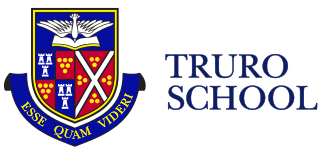
Truro School is a coeducational private boarding and day school located in the city of Truro, Cornwall, England. It is the largest coeducational independent school in Cornwall with over 1050 pupils from pre-prep to sixth form. It is a member school of the Headmasters' and Headmistresses' Conference.
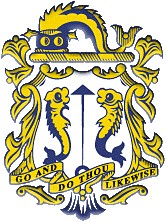
Collegiate School is a private day school in Bristol, England, and is a member of the Headmasters' and Headmistresses' Conference.

The Royal Hospital School is a British co-educational fee-charging boarding and day school with naval traditions. The school admits pupils from age 11 to 18 through Common Entrance or the school's own exam. The school is regulated by Acts of Parliament.

King Edward's Witley is a private co-educational boarding and day school, founded in 1553 by King Edward VI and Nicholas Ridley, Bishop of London and Westminster, in The Palace of Bridewell near Fleet St in the City of London. The School is located in the village of Wormley, Surrey, England, having moved to its present location in 1867. The School became fully co-educational in 1952. As of September 2010, the school has joined the small number of independent schools in the UK which offer the IB Diploma Programme in place of A-Levels in the sixth form. The school re-introduced A-levels as part of the curriculum from September 2015.

The Royal College of Elizabeth, better known as Elizabeth College, is a co-educational independent school in Saint Peter Port, Guernsey. A member of the HMC, it is a public school in the British sense of the term. Founded on 25 May 1563 by royal charter from Elizabeth I, it is one of the oldest schools in the British Isles and the oldest public school in the Channel Islands.

Queen Elizabeth's High School is a mixed grammar school in Gainsborough, Lincolnshire, England. The school, established in 1983, but with a timeline to 1589, is an amalgamation of the previous Gainsborough High School and Queen Elizabeth's Grammar School.

Redland High School for Girls was a selective and independent, non-denominational girls' school in the suburb of Redland, Bristol, England. The school merged with The Red Maids' School in May 2016, with the new merged school named Redmaids' High School and based at the Red Maids' site from September 2017 in Westbury-on-Trym.
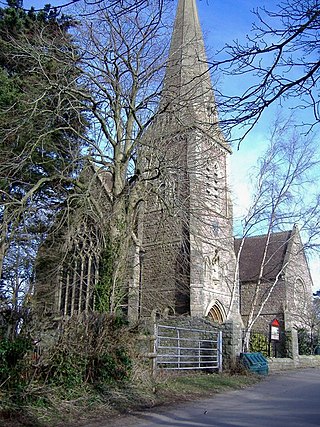
Failand is a village in Somerset, England. It lies within the civil parish of Wraxall and Failand and the unitary authority area of North Somerset.

Trent College is a co-educational independent boarding and day school located in Long Eaton, Derbyshire between Nottingham and Derby. Founded in 1868 as a local ’middle class alternative’ to the more famous public schools, it is now a coeducational school and a member of the Headmasters' and Headmistresses' Conference.
Adrian Jarvis is an English rugby union footballer who played as fly half for Bristol in the RFU Championship.
Bristol is the largest city in South West England, and as such is a centre for culture, research and higher education in the region. The city is home to a prestigious "red brick university" and a high-ranking "new university". The city is also noted for its investment in the sciences and engineering, particularly its ties to the aerospace industry.

Queen Elizabeth's Grammar School is a selective co-educational grammar school with academy status in Faversham, Kent, southeast England. It was formed in 1967, when the Queen Elizabeth 1 Grammar School for Boys and the William Gibbs School for Girls merged and moved into new accommodation opposite.
Queen Elizabeth High School (QEHS) is a coeducational high school and sixth form located in Hexham, Northumberland, England.
The Elizabethan Academy is a secondary school with academy status located in the Nottinghamshire market town of Retford, England. It is situated to the north of Retford town centre, to the east of the A638, on the side of the River Idle once known as West Retford. The academy has specialist status in Science and Mathematics.
Queen Elizabeth School, also abbreviated to QES, is a coeducational, comprehensive secondary school and sixth form with academy status. It is located in Kirkby Lonsdale, in the English county of Cumbria. In October 2022, it had a population of 1,170 students aged 11 to 18 in KS3 and KS4, and 186 in the sixth form.
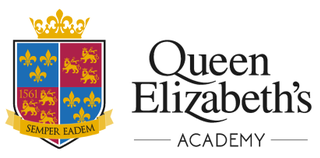
Queen Elizabeth's Academy is a co-educational Church of England secondary school and sixth form located in Mansfield in the English county of Nottinghamshire.
